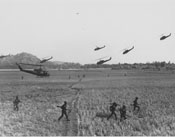Vietnam: The Helicopter War
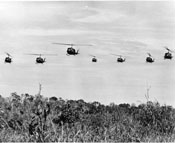
UH-1B helicopters airlift members of the 1st Battalion, 28th Infantry, 1st Infantry Division
U.S. Army Aviation Museum Volunteer Archivists Collection [VA058729]
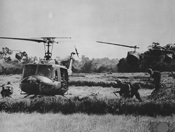
Troops of the 173rd Airborne Division dash to helicopters during Operation Dexter
Glenn Helm Collection [VA040233]
The Helicopter War
The advent of the helicopter in the early 20th century had a profound impact on transportation, communication, and myriad other areas of human endeavor. Warfare also experienced an important transformation at the operational and tactical levels as a result of rotary wing technology, and has perhaps had an equally important influence on the development of the helicopter. Helicopters afforded rapid transportation of fighting forces on the battlefield, and have also evolved to embrace a much larger role as an efficient and deadly weapons platform, but also serve vital support roles in medical evacuation, logistical operations, search and rescue operations, and in many other uses. In many ways, the evolution of the military helicopter mirrors the rapid changes of American society while still reflecting Americans' faith in technology and efficiency.
The United States first employed helicopters in warfare during the Second World War. When downed American bombers in Burma could not be reached by the vaunted American glider forces, helicopters were called in and successfully extracted the flight crews. Recognizing the immense potential of the helicopter, military planners focused on developing a rotary wing force to buttress the American arsenal. The Korean War witnessed a much wider usage of helicopters, most famously with the H-13 and its role in the medical evacuation of wounded personnel to field hospitals, but in minor troop insertions and in a limited reconnaissance role, as well.
During the Vietnam War, the United States relied on the helicopter as never before. The helicopter's role in combat expanded enormously in this conflict as thousands of "choppers" rapidly transported personnel throughout the war zone. Heavily armed helicopters offered a fearsome component to ground operations as close air support. Mobility and firepower would be the keys for American operations in Vietnam, and the helicopter provided an abundance of both. But the role of the helicopter in support activities in the Vietnam War must not be overlooked, as thousands of missions were flown to resupply and reinforce troops on the ground, to evacuate American and South Vietnamese wounded, and to offer countless other services in pursuance of the war effort. The UH-1 "Huey" is the ubiquitous symbol of the American war in Vietnam. Indeed, the Vietnam War was the Helicopter War.
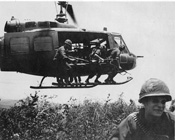
UH-1 helicopter, aerial delivery of personnel
U.S. Army Aviation Museum Volunteer Archivists Collection [VA058502]
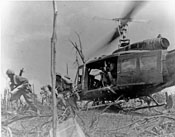
UH-1 helicopter, aerial delivery of personnel
U.S. Army Aviation Museum Volunteer Archivists Collection [VA058751]
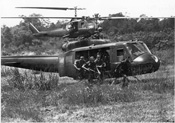
UH-1 helicopter, aerial delivery of personnel
U.S. Army Aviation Museum Volunteer Archivists Collection [VA058497]
Bibliography
- Allen, Matthew. Military Helicopter Doctrines of the Major Powers, 1945-1992. Westport, CT: Greenwood Press, 1993.
- Boyne, Walter J. How the Helicopter Changed Modern Warfare. Gretna, LA: Pelican Publishing Company, Inc., 2011.
- Everett-Heath, John. Helicopters in Combat. NY: Sterling Publishing Company, 1992.
- House, Jonathan M. Toward Combined Arms Warfare: A Survey of 20th Century Tactics, Doctrine, and Organization. Fort Leavenworth, KS: U.S. Army Command and General Staff College, 1984.
- Kreisher, Otto. "The Rise of the Helicopter During the Korean War," at http://historynet.com/the-rise-of-the-helicopter-during-the-korean-war.htm (originally published in Aviation History).
- 2930113008, Designation of Army Aircraft, 07 March 1968, Folder 13, Box 01, Vietnam Helicopter Pilots Association (VHPA) Collection: General Files, The Vietnam Center and Sam Johnson Vietnam Archive, Texas Tech University.
- VA004065, Douglas Pike Photograph Collection, The Vietnam Center and Sam Johnson Vietnam Archive, Texas Tech University
- VA058545, U.S. Army Aviation Museum Volunteer Archivists Collection, The Vietnam Center and Sam Johnson Vietnam Archive, Texas Tech University
- VA040233, Glenn Helm Collection, The Vietnam Center and Sam Johnson Vietnam Archive, Texas Tech University
- VA058497, U.S. Army Aviation Museum Volunteer Archivists Collection, The Vietnam Center and Sam Johnson Vietnam Archive, Texas Tech University
- VA058502, U.S. Army Aviation Museum Volunteer Archivists Collection, The Vietnam Center and Sam Johnson Vietnam Archive, Texas Tech University
- VA058729, U.S. Army Aviation Museum Volunteer Archivists Collection, The Vietnam Center and Sam Johnson Vietnam Archive, Texas Tech University
- VA058751, U.S. Army Aviation Museum Volunteer Archivists Collection, The Vietnam Center and Sam Johnson Vietnam Archive, Texas Tech University
- VA059095, U.S. Army Aviation Museum Volunteer Archivists Collection, The Vietnam Center and Sam Johnson Vietnam Archive, Texas Tech University
Vietnam Center & Sam Johnson Vietnam Archive
-
Address
Texas Tech University, Box 41041, Lubbock, TX 79409 -
Phone
(806)742-9010 -
Email
vnca@ttu.edu


